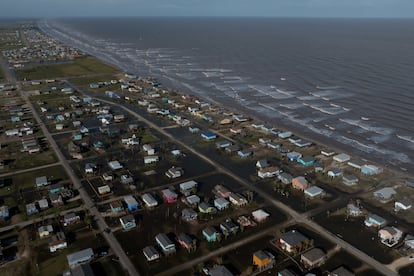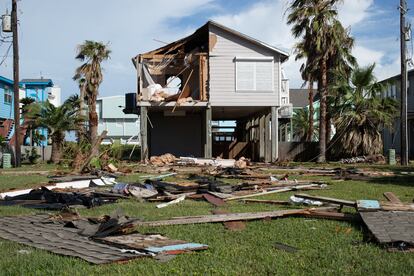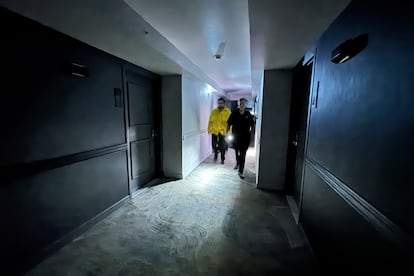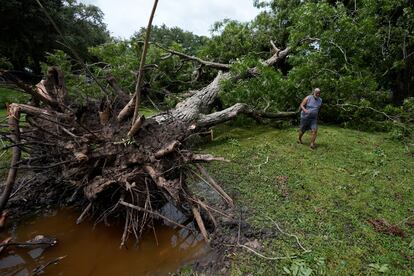After Beryl tears through Texas, residents are caught between persistent flooding and rising temperatures
The storm left at least eight dead and millions remain without power, increasing the risk of heat-related illnesses as a heat wave grips the entire country

After the storm, the calm has yet to reach Texas. After Beryl tore through the state on Monday, leaving at least eight dead — in the first of a hurricane season that is expected to be historic — the risk of flooding persists as temperatures increase, driven by a heat wave that is affecting the entire country. State authorities estimate that returning power to the nearly three million homes and businesses that suffered outages from the Category 1 storm will take anywhere from a few days to two weeks.
Acting Governor Dan Patrick, who is filling in for Greg Abbott while the latter is out of the country, announced that energy company CenterPoint Energy will bring in thousands of additional workers to restore power. According to Patrick, the hurricane took down 10 transmission lines and many of the service outages were caused by downed trees. Fallen trees also caused several of the deaths attributed to Beryl, along with a house fire believed to have been caused by lightning, and drowning.

When Beryl made landfall in Texas on Monday it was far from the Category 5 hurricane that had destroyed Caribbean islands and hit parts of Mexico a few days earlier; by then it had been downgraded to tropical storm, but it still unleashed heavy rains. In a short time the flooding had trapped dozens of cars on streets and highways, while the winds knocked down hundreds of trees, already fragile due to the saturated soil. In the coming days the storm is expected to affect several other states. According to the National Hurricane Center, dangerous winds and flash flooding will continue as the storm moves forward.
As the dark clouds of Beryl gave way to the harsh summer sun, the need to restore power became increasingly urgent as Texas grapples with a heat wave. In the Houston metropolitan area, the fourth most populated city in the country, more than two million homes and businesses suffered outages due to storms for the second time this year, while temperatures were forecast to climb into the mid-90s on Wednesday. The National Weather Service in Houston had a heat advisory in place for Wednesday, warning that “with power outages continuing across South-East Texas, the lack of air conditioning will aggravate the risk for heat-related illnesses.”
In the city of Galveston, south of Houston, authorities warned of difficulties still ahead. “As efforts move full steam ahead, we want residents to be aware and prepare for a possible multi-day outage. The estimate is between 72 hours and two weeks in some areas.”

On Monday afternoon in Houston, the sound of chainsaws echoed as citizens got to work clearing streets and sidewalks of trees and branches that were blocking the roads. But acting governor Patrick warned that flooding could return within the week if heavy rain fell on already highly saturated areas.
The situation has also affected the industrial engine of the state. This area of Texas has a large number of oil refineries and several companies announced that it has become necessary to activate flaring —the burning of residual or preventive natural gas due to pressure changes in the plant— because of changes in the electrical supply. It is not yet clear how much gas was burned, nor what impact on emissions this may have had.
Beryl, the fastest storm to become a Category 5 hurricane in the Atlantic, caused at least 11 deaths as it passed through the Caribbean towards Texas. The storm ripped off doors, windows and roofs with devastating winds and tides fueled by record-breaking Atlantic heat. On three occasions in the past week, Beryl increased its wind speed by 35 miles per hour (56 km/h) in 24 hours or less, the official definition of rapid intensification.
Beryl’s explosive growth is due to warm water from the Atlantic and Caribbean and is just a prelude to what the Atlantic hurricane belt can expect for the rest of the season, experts have warned. In Jamaica, authorities said Monday that island residents will face food shortages after Beryl destroyed more than $6.4 million worth of crops and infrastructure.

In Louisiana, “the risk will be for heavy rain and the potential for flash flooding,” the National Weather Service said. State meteorologists are also watching out for “fast-moving tornadoes,” said Donald Jones, a meteorologist with the National Weather Service in Lake Charles, Louisiana. “It’s just a matter of exactly where it’s going to be,” Jones added. “It is very difficult to predict it more than an hour in advance.”
Beryl is forecast to bring more rain and strong winds to other states in the coming days. One of them, Missouri, is already dealing with a wet summer. Heavy rains unrelated to the storm prompted several water rescues around the city of Columbia, where rivers and streams were already swollen before Beryl’s arrival on Tuesday.
Sign up for our weekly newsletter to get more English-language news coverage from EL PAÍS USA Edition
Tu suscripción se está usando en otro dispositivo
¿Quieres añadir otro usuario a tu suscripción?
Si continúas leyendo en este dispositivo, no se podrá leer en el otro.
FlechaTu suscripción se está usando en otro dispositivo y solo puedes acceder a EL PAÍS desde un dispositivo a la vez.
Si quieres compartir tu cuenta, cambia tu suscripción a la modalidad Premium, así podrás añadir otro usuario. Cada uno accederá con su propia cuenta de email, lo que os permitirá personalizar vuestra experiencia en EL PAÍS.
¿Tienes una suscripción de empresa? Accede aquí para contratar más cuentas.
En el caso de no saber quién está usando tu cuenta, te recomendamos cambiar tu contraseña aquí.
Si decides continuar compartiendo tu cuenta, este mensaje se mostrará en tu dispositivo y en el de la otra persona que está usando tu cuenta de forma indefinida, afectando a tu experiencia de lectura. Puedes consultar aquí los términos y condiciones de la suscripción digital.
More information
Archived In
Últimas noticias
Maude Apatow, from acting in ‘Euphoria’ to directing: ‘There are many films that you can tell weren’t written by someone young’
The life of a delivery driver in China: ‘Many people don’t know how an order can arrive at their home in just one day’
Can cheese protect brain health? This is what the science says
Helen Levitt, the photographer who captured the theater of the everyday
Most viewed
- Christian Louboutin: ‘Young people don’t want to be like their parents. And if their parents wear sneakers, they’re going to look for something else’
- US sanctions against jailed cartel leader ‘El Marro’ highlight Mexico’s lack of control over its prisons
- Cartels in Mexico take a leap forward with narco-drones: ‘It is criminal groups that are leading the innovation race’
- Liset Menéndez de la Prida, neuroscientist: ‘It’s not normal to constantly seek pleasure; it’s important to be bored, to be calm’
- ‘El Limones’ and the growing union disguise of Mexican organized crime











































